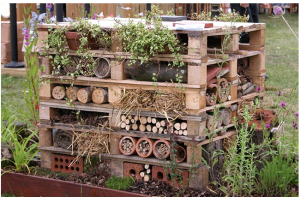All posts tagged create
Getting kids outside and teaching them about insects is an important part of childhood. Encourage kids to not be afraid of bugs. Exploring safe creatures such as the Pill Bug or Rollie Pollie‘s as most kids call them is a great way to start young explorers off with insects. Kids can learn about the stages of a bugs life from egg to adult. They can also do a bit of research at their local library after a day of outdoor play and learn that Pill bugs are actually not insects, they are crustaceans. They are related to shrimp and crayfish, breathe with gills, and need humidity or moisture to survive.

With this knowledge they could build a Rollie Pollie habitat to study and observe these creatures.
Share nature with kids while they are young and you will create, in them, a life long love of the outdoors. This is important to cultivate future scientists, conservators and explorers along with naturalists and artists inspired by nature.
Insect habitats teach kids so many life lessons. Ants demonstrate the importance of working together. Praying mantids teach children about the food chain. Butterflies exhibit the beauty of metamorphosis bot to mention lessons in biomimicry. Bugs and insects make ideal pets for children who cannot own larger domesticated animals due to allergies, housing restrictions, or family finances. There are many prefabricated habitats available in the marketplace, but parents and children can also build their own. Check out this bug mansion:
This week I am kicking off a summer long series inspired by our love of STEAM and nature. I will focus on all kinds of ways to get kids out of the house and off of their tech this summer. It can be hard for working parents to take kids out so I am going to give examples of quick walks, small container planting, and ‘gulp’ . . . unsupervised play.
Want to get started with planning to keep you kids from getting Nature-Deficit Disorder this summer? Start here and read Richard Louv‘s book Last Child in the Woods: Saving Our Children From Nature-Deficit Disorder
From the book:
“I like to play indoors better ’cause that’s where all the electrical outlets are,” reports a fourth-grader. Never before in history have children been so plugged in-and so out of touch with the natural world. In this groundbreaking new work, child advocacy expert Richard Louv directly links the lack of nature in the lives of today’s wired generation-he calls it nature deficit-to some of the most disturbing childhood trends, such as rises in obesity, Attention Deficit Disorder (Add), and depression. Some startling facts: By the 1990s the radius around the home where children were allowed to roam on their own had shrunk to a ninth of what it had been in 1970. Today, average eight-year-olds are better able to identify cartoon characters than native species, such as beetles and oak trees, in their own community. The rate at which doctors prescribe antidepressants to children has doubled in the last five years, and recent studies show that too much computer use spells trouble for the developing mind. Nature-deficit disorder is not a medical condition; it is a description of the human costs of alienation from nature. This alienation damages children and shapes adults, families, and communities. There are solutions, though, and they’re right in our own backyards. Last child in the Woods is the first book to bring together cutting-edge research showing that direct exposure to nature is essential for healthy childhood development-physical, emotional, and spiritual. What’s more, nature is a potent therapy for depression, obesity, and Add. Environment-based education dramatically improves standardized test scores and grade point averages and develops skills in problem solving, critical thinking, and decision making. Even creativity is stimulated by childhood experiences in nature.
 Outdoor Dance Party!
Outdoor Dance Party!
Let’s make this the summer of outdoor play and exploration. We need more scientists and engineers and artists who are inspired by nature. The Children and Nature Movement is forming – Want to know more about how you can get involved? Click HERE

